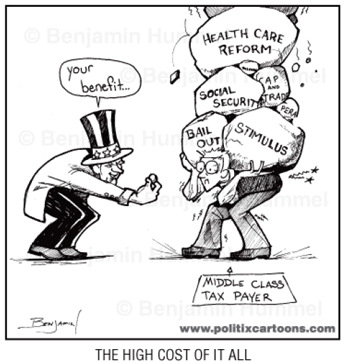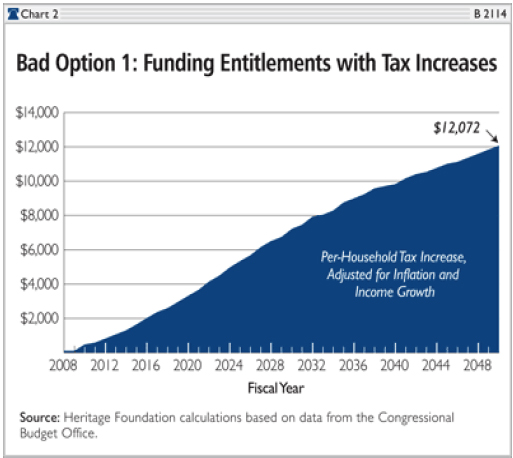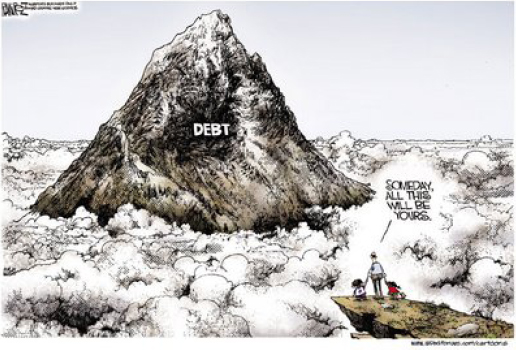Raising young deficit hawks
By leaving that out, Ghilarducci told Remapping Debate, the curriculum creates an exaggerated impression of Social Security’s vulnerability. The same effect is created, she said, by repeated cases in which the lessons lump Social Security with Medicare and Medicaid, two programs that face far more serious long-term problems.
James Galbraith, professor of government at the University of Texas, pointed out that the lesson containing Ghilarducci’s proposal leads off with an “essential question,” namely: “Should mandatory programs like Medicare, Medicaid, and Social Security be modified to address the national debt?” Not, “What is the national debt? Is it a problem?” Galbraith said. “Not ‘Should anything be done to address the national debt?’ Just ‘Should Medicare, Medicaid, and Social Security be modified to address the national debt?’”
Driving home the point
Students might be led to answer “yes” after browsing over the series of worrisome graphs, charts, and visual materials that accompany the chapter. Among them: a cartoon depicting a middle-class taxpayer staggering under the weight of “the programs piled on the taxpayer’s back” (see cartoon at right); charts showing U.S. debt at historically high levels and illustrating the hefty share of federal spending taken up by Social Security, health programs, and defense; a graph suggesting that current spending trends are “not sustainable”; a second cartoon depicting a parent having to tell his young child that a towering and ominous mountain of debt will someday “all be yours” (see cartoon at bottom of page); and a second graph (this one supplied by the conservative Heritage Foundation) purporting to demonstrate the apparent futility of trying to address the entitlement programs’ problems with tax increases (see graph below). The last point is reinforced by the graph maker’s decision to present the cost of such tax increases as rising to the point where, by the year 2048, it would amount to an extra $12,078 “per household,” suggesting that the burden might fall equally on all households. That would only be the case, however, if the U.S. had meanwhile chosen to abandon its longstanding commitment to the principle of progressive taxation, in which high earners pay a bigger share of their income than lower wage earners do.
The difficulties of raising sufficient revenue to make a serious fiscal difference are dramatized again in Lesson 3, “Taxation and the Federal Budget.” Here, all except one of the proposed tax measures — “Return the Estate Tax to levels set in 2001, before the Bush tax cuts” — involve personal income taxes. The lesson does not consider higher corporate taxes (or fewer corporate tax breaks), a financial transaction tax, or taxing capital gains as ordinary income — three options with the potential to raise large sums of money and make a major dent in the deficit without raising the tax obligations of the vast majority of Americans.
Remapping Debate raised these questions, and others, with Professor Marri. In a number of the specific cases cited, the lessons might appear to be skewed or lacking important context, he acknowledged. But the curriculum is a work in progress, Marri added, and such problems will be addressed as time goes on.
How? Sometimes by adding a fact, sometimes by changing the sequence of material, sometimes by inserting a qualifying phrase such as “Some economists say…” That, for example, was how Marri proposed to deal with a passage in an introductory piece declaring that “our existing tax structure and government spending patterns, the rapidly rising cost of the way we deliver health care, and our mandated commitment to provide Medicare for a ‘booming’ population of retirees age 65 and older have put our economy on an unsustainable course.”
“The current budget deficit is $1.4 trillion or about 10% of the nation’s Gross Domestic Product (GDP) of $14.5 trillion,” students learn at the beginning of Lesson 6, entitled “The Federal Budget and the ‘Graying’ of America.’” Remapping Debate asked Marri about the failure to link those striking figures to three factors that go a long way toward explaining them: the tax cuts of 2001 and 2003, the unfunded wars in Iraq and Afghanistan, and the revenue declines and spending increases occasioned by the severe economic contraction of 2008-09. The curriculum’s authors are preparing a lesson on the Bush tax cuts, Marri answered. But he added that they had generally chosen to downplay events of the recent past, because “we didn’t want the lessons to get outdated.”
How was the project created?
It was Teachers College that approached the Peterson Foundation, at first with the idea of a curriculum based on a Peterson-sponsored documentary, “IOUSA.” Originally, the focus was going to be on personal finance. But the Peterson foundation preferred to emphasize public finance. The foundation, as it happened, had a far bigger project in mind than the one envisioned by Marri and his colleagues: their $50,000 application ended up as a $2.4 million grant for a curriculum focused on the federal budget, the national debt, and the deficit. “These are three things that are important for kids to know about,” Marri said, adding that the choice of those particular topics was “how we got this project.”
Marri pointed out more than once, however, that students would be encouraged to think about how to “address our fiscal challenges in a manner that is consistent with our values and traditions — that’s the essential question of the curriculum,” Marri said.
The decision to make “fiscal challenges” the frame within which values are discussed is different, of course, from Andrew Fieldhouse’s proposed alternative — one that begins with values, traditions, and societal goals and choices, and then, within such a policy framework, assesses how to fund those choices most appropriately.



